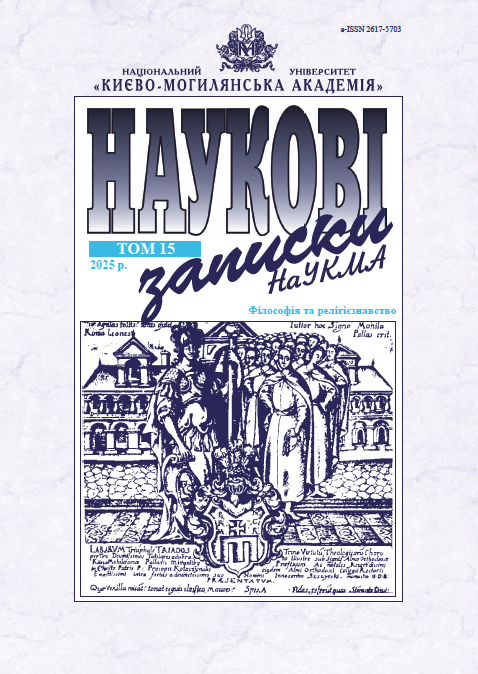Особа і діяльність Святого Духа в монашому житті і творах пізньої античності
DOI:
https://doi.org/10.18523/2617-1678.2025.15.33-41Ключові слова:
Святий Дух, благодать, дари Святого Духа, історія, діяльність, чудеса, подвижники, патристика, аскетикаАнотація
Доктрина Трійці, щодо якої точилися запеклі дискусії протягом IV століття, є одним із ключових учень християнської церкви. Дослідники здебільшого зосереджуються на теоретичних положеннях та історичному розвитку цього догмату. Однак, на думку християн, Бог є живим і є не просто поняттям, а Особою. Тож було цікаво побачити, як цю теоретичну ідею Бога розуміли та реалізовували у практичному житті, у житті святих людей, які в ідеалі мають тісний контакт із Богом і особливо зі Святим Духом, який став більш присутнім і активним у житті церкви після П’ятидесятниці. У цій статті досліджено сприйняття третьої Особи Трійці та Його ролі в житті аскетів у таких грекомовних творах, як анонімна «Історія єгипетських ченців» (400), «Історія Лаузіака» (419/420) Палладія та «Історія сирійських ченців» (440) Феодорита Кирського. Тут розглянуто, як ці автори описували життя подвижників і їхні стосунки зі Святим Духом і як ці стосунки розуміли самі ченці. Зокрема, було досліджено роль благодаті Духа в надприродному житті подвижників, як Бог «використовував» подвижників як знаряддя спасіння всіх людей, зв’язок між благодаттю Духа та діями людини в процесі спасіння і ставлення подвижників до єретиків і язичників. Незважаючи на те, що, як ми виявили, вони підходили до Святого Духа як до живої Особи, а не як до раціональної концепції, було досліджено, чи вчення про Духа «просочилися» в літературні життєписи святих і яким способом.
Завантаження
Посилання
- Bilaniuk, P. B. T. (1980). The Monk as Pneumatophor in the Writings of St Basil the Great. Diakonia, 15 (1), 49–63.
- Bolgiani, F. (1979). La théologie de l’Esprit Saint: de la fin du Ier siècle au Concile de Constantinople (381). Quatres fleuves, 9. Éditions Beauchesne, 33–72.
- Buda, D. (2019). Theodoret of Cyrus on Messalianism. Studia Universitatis Babes-Bolyai Theologia Orthodoxa, 64 (2), 51–62.
- Burns, S. K. (1999). Charisma and Spirituality in the Early Church: A Study of Messalianism and Pseudo-Macarius. [Unpublished doctoral dissertation]. Leeds University.
- Cain, A. (2012). The Style of the Greek Historia Monachorum in Aegypto. Revue d’études Augustiniennes et Patristiques, 58, 57–96.
- Cain, A. (2016). The Greek Historia Monachorum in Aegypto: Monastic Hagiography in the Late Fourth Century. Oxford Early Christian Studies. Oxford University Press.
- Caner, D. (2002). Wandering, Begging Monks: Spiritual Authority and the Promotion of Monasticism in Late Antiquity. University of California Press.
- Edwards, M. (2009). Catholicity and Heresy in the Early Church. Ashgate.
- Elm, S. (1994). ‘Virgins of God’: The Making of Asceticism in Late Antiquity. Clarendon Press.
- Frank, G. (1998). Miracles, Monks, and Monuments: The Historia Monachorum in Aegypto as Pilgrims’ Tales. In D. Frankfurter (Ed.), Pilgrimage and Holy Space in Late Antique Egypt. Religions in the Graeco-Roman World, 134 (pp. 483–505). Brill.
- Goehring, J. E. (1999). Ascetics, Society, and the Desert: Studies in Early Egyptian Monasticism. T&T Clark.
- Gregory of Nazianzus. (2002). On God and Christ: The Five Theological Orations and Two Letters to Cledonius. Popular Patristics. St. Vladimir’s Seminary Press.
- Harmless, W. S. J. (2004). Desert Christians: An Introduction to the Literature of Early Monasticism. Oxford University Press.
- Humphries, T. L. (2013). Ascetic Pneumatology from John Cassian to Gregory the Great. Oxford University Press.
- Jullien, F. (2019). Forms of the Religious Life and Syriac Monasticism. In D. King (Ed.), The Syriac World (pp. 88–104). Routledge.
- Katos, D. S. (2012). Palladius of Helenopolis: The Origenist Advocate. Oxford Early Christian Studies. Oxford University Press.
- McIntyre, J. (1954). The Holy Spirit in Greek Patristic Thought. SJT, 7 (4), 353– 375.
- Moschos, D. (2003). Eschatology in Egyptian Monasticism: Based on the Historia Monachorum in Aegypto and the Lausiac History. In P. Kalaïtzidis (Ed.), The Church and Eschatology (pp. 191–221). Athens.
- Palladius. (1965). The Lausiac History (R. T. Meyer, Transl.). Ancient Christian Writers 34.
- Rapp, C. (2001). Paladius Lausus and the Historia Lausiaca. In C. Sode & S. Takács (Eds.), Novum Millennium: Studies on Byzantine History and Culture Dedicated to Paul Speck (pp. 279–289). Ashgate.
- Rapp, C. (2005). Holy Bishops in Late Antiquity: The Nature of Christian Leadership in an Age of Transition. University of California Press.
- Russell, N. (2006). The Doctrine of Deification in the Greek Patristic Tradition. Oxford Early Christian Studies. Oxford University Press.
- Sheridan, M. (2015). Early Egyptian Monasticism: Ideals and Reality, or The Shaping of the Monastic Ideal. Journal of the Canadian Society for Coptic Studies, 7, 9–24.
- The Lives of the Desert Fathers: Historia Monachorum in Aegypto. (1981). (N. Russell, Transl.). Cistercian Studies 34. Cistercian Publications.
- Theodoret of Cyrrhus. (1985). A History of the Monks of Syria (R. M. Price, P. Canivet, & A. Leroy-Molinghen, Transl.). Cistercian Publications.
- Wipszycka, E. (2018). The Second Gift of the Nile: Monks and Monasteries in Late Antique Egypt (D. Jasiński, Transl.). Supplements to the Journal of Juristic Papyrology, 33. University of Warsaw.
##submission.downloads##
Опубліковано
Як цитувати
Номер
Розділ
Ліцензія
Авторське право (c) 2025 Yuliia Rozumna

Ця робота ліцензується відповідно до Creative Commons Attribution 4.0 International License.
Автори, які публікуються у цьому журналі, погоджуються з такими умовами:
а) Автори зберігають за собою авторські права на твір на умовах ліцензії Creative Commons Attribution License CC BY 4.0, котра дозволяє іншим особам вільно поширювати (копіювати і розповсюджувати матеріал у будь-якому вигляді чи форматі) та змінювати (міксувати, трансформувати, і брати матеріал за основу для будь-яких цілей, навіть комерційних) опублікований твір на умовах зазначення авторства.
б) Журнал дозволяє автору (авторам) зберігати авторські права без обмежень.
в) Автори мають право укладати самостійні додаткові угоди щодо поширення твору (наприклад, розміщувати роботу в електронному репозитарії), за умови збереження посилання на його першу публікацію. (Див. Політика Самоархівування)
г) Політика журналу дозволяє розміщення авторами в мережі Інтернет (наприклад, у репозитаріях) тексту статті, як до подання його до редакції, так і під час його редакційного опрацювання, оскільки це сприяє виникненню продуктивної наукової дискусії та позитивно позначається на оперативності та динаміці цитування опублікованої роботи (див. The Effect of Open Access).



